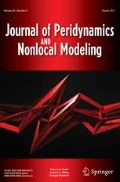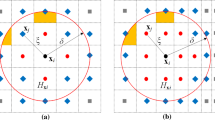Abstract
Isogeometric analysis (IGA) is an important mesh-free method which utilizes the splines basis functions and control net in the CAD geometry for simulation. Its theoretical basis is continuum mechanics, and it is not suitable for fracture problems. Peridynamics (PD) is a non-local theory based on integral equations, which is suitable for discontinuous problems such as cracks, while the non-local property of PD increases the computational effort. The coupling of IGA and PD promotes the simulation of cracks with the precise CAD geometry and improves the computational efficiency compared with that of pure PD model. In this paper, the coupling approach of IGA and PD (IGA-PD) for plane problems with non-uniform control net is introduced, and the main contribution is a system of algorithms to convert the non-uniform control net into IGA-PD coupling model. A volume division method is proposed to calculate the occupied volumes for the PD nodes. To account for the non-uniform control net, the search range correction method, volume and centroid correlation methods of family nodes and dual-horizon method are applied to improve the computational precision. An exponential gradual constitutive model (EGCM) is applied to calculate the crack propagation of materials. The proposed IGA-PD model with non-uniform control net makes full use of the advantages of the non-local continuum theory, which can solve the fracture problem and alleviate the surface effect of PD. The processing algorithms for the non-uniform control net improve the computational accuracy. Numerical examples of static problems and crack propagations are given. The results prove that the search range, centroid and volume correction methods are important for improving the numerical precision. The plate under stretch and bending, Kalthoff–Winkler impact problem and simulation of concrete material are carried out to show the effectiveness of the proposed IGA-PD model.
























Similar content being viewed by others
References
Hughes T, Cottrell J, Bazilevs Y (2005) Isogeometric analysis: CAD, finite elements, NURBS, exact geometry and mesh refinement. Comput Methods Appl Mech Eng 194(39):4135–4195
Moës N, Dolbow J, Belytschko T (1999) A finite element method for crack growth without remeshing. Int J Numer Methods Eng 46(1):131–150
Bobaru F, Zhang GF (2015) Why do cracks branch? A peridynamic investigation of dynamic brittle fracture. Int J Fract 196(1–2):59–98
Benson DJ, Bazilevs Y, De Luycker E, Hsu MC, Scott M, Hughes TJR, Belytschko T (2010) A generalized finite element formulation for arbitrary basis functions: From isogeometric analysis to xfem. Int J Numer Methods Eng 83(6):765–785
Naderi M, Sarkar S, Amiri M, Iyyer N (2016) Extended isogeometric analysis (XIGA) of fatigue life in attachment lug. J Fail Anal Prev 16(4):601–611
Nguyen VP, Anitescu C, Bordas SP, Rabczuk T (2015) Isogeometric analysis: An overview and computer implementation aspects. Math Comput Simul 117:89–116
Silling SA (2000) Reformulation of elasticity theory for discontinuities and long-range forces. J Mech Phys Solids 48(1):175–209
Silling SA, Askari E (2005) A meshfree method based on the peridynamic model of solid mechanics. Comput Struct 83(17):1526–1535
Lubineau G, Azdoud Y, Han F, Rey C, Askari A (2012) A morphing strategy to couple non-local to local continuum mechanics. J Mech Phys Solids 60(6):1088–1102
Han F, Lubineau G, Azdoud Y (2016) Adaptive coupling between damage mechanics and peridynamics: A route for objective simulation of material degradation up to complete failure. J Mech Phys Solids 94:453–472
Han F, Lubineau G, Azdoud Y, Askari A (2016) A morphing approach to couple state-based peridynamics with classical continuum mechanics. Comput Methods Appl Mech Eng 301:336–358
Wildman RA, O’Grady JT, Gazonas GA (2017) A hybrid multiscale finite element/peridynamics method. Int J Fract 207(1):41–53
Yu YT, Zhang Q, Gu X (2017) Hybrid model of peridynamics and finite element method under implicit schemes. Journal of Zhejiang University (Engineering Science) 51(7):1324–1330
Bie YH, Li S, Hu X, Cui XY (2019) An implicit dual-based approach to couple peridynamics with classical continuum mechanics. Int J Numer Methods Eng 120(12):1349–1379
Shojaei A, Mudric T, Zaccariotto M, Galvanetto U (2016) A coupled meshless finite point/peridynamic method for 2d dynamic fracture analysis. Int J Mech Sci 119:419–431
Galvanetto U, Mudric T, Shojaei A, Zaccariotto M (2016) An effective way to couple fem meshes and peridynamics grids for the solution of static equilibrium problems. Mech Res Commun 76:41–47
Zaccariotto M, Mudric T, Tomasi D, Shojaei A, Galvanetto U (2018) Coupling of fem meshes with peridynamic grids. Comput Methods Appl Mech Eng 330:471–497
Xia Y, Meng XH, Shen GZ, Zheng GJ, Hu P (2021) Isogeometric analysis of cracks with peridynamics. Comput Methods Appl Mech Eng 377:113700
Zheng GJ, Shen GZ, Hu P, Xia Y (2020) Coupling approach of isogeometric analysis with non-ordinary state-based peridynamics. Eur J Mech A Solids 82:103981
Wildman R, O’Grady J, Gazonas G (2017) A hybrid multiscale finite element/peridynamics method. Int J Fract 207(1):41–53
Ren HL, Zhuang XY, Rabczuk T (2017) Dual-horizon peridynamics: A stable solution to varying horizons. Comput Methods Appl Mech Eng 318:762–782
Zingales M, Paola MD, Inzerillo G (2011) The finite element method for the mechanically based model of non-local continuum. Int J Numer Methods Eng 86(13):1558–1576
Yaghoobi A, Chorzepa MG (2018) Formulation of symmetry boundary modeling in non-ordinary state-based peridynamics and coupling with finite element analysis. Math Mech Solids 23(8):1156–1176
Ni T, Zhu QZ, Zhao LY, Li PF (2018) Peridynamic simulation of fracture in quasi brittle solids using irregular finite element mesh. Eng Fract Mech 188:320–343
Bobaru F, Ha YD, Hu W (2010) Numerical integration in peridynamics[r]. Department of Mechanical Materials Engineering
Parks ML, Lehoucq RB, Plimpton SJ, Silling SA (2008) Implementing peridynamics within a molecular dynamics code. Comput Phys Commun 179(11):777–783
Parks ML, Plimpton SJ, Lehoucq RB, Silling SA (2008) Peridynamics with lammps: A user guide. Sandia National Laboratory Report, SAND2008-0135, Albuquerque, New Mexico
Seleson P (2014) Improved one-point quadrature algorithms for two-dimensional peridynamic models based on analytical calculations. Comput Methods Appl Mech Eng 282:184–217
Ren HL, Zhuang XY, Cai YC, Rabczuk T (2016) Dual-horizon peridynamics. Int J Numer Methods Eng 108(12):1451–1476
Zheng GJ, Wang JL, Shen GZ, Xia Y, Li WD (2021) A new quadrature algorithm consisting of volume and integral domain corrections for two-dimensional peridynamic models. Int J Fract 229(1):39–54
Rabczuk T, Ren HL, Zhuang XY (2019) A nonlocal operator method for partial differential equations with application to electromagnetic waveguide problem. Computers, Materials & Continua 59(1):31–55
Ren HL, Zhuang XY, Oterkus E, Zhu HH, Rabczuk T (2021) Nonlocal strong forms of thin plate, gradient elasticity, magneto-electro-elasticity and phase field fracture by nonlocal operator method. arXiv 2103.08696
Ren HL, Zhuang XY, Rabczuk T (2020) A nonlocal operator method for solving partial differential equations. Comput Methods Appl Mech Eng 358:112621
Silling SA (2021) Kinetics of failure in an elastic peridynamic material. Journal of Peridynamics and Nonlocal Modeling 3:1–23
Tong Y, Shen WQ, Shao JF, Chen JL (2020) A new bond model in peridynamics theory for progressive failure in cohesive brittle materials. Eng Fract Mech 223:106767
Macek RW, Silling SA (2007) Peridynamics via finite element analysis. Finite Elem Anal Des 43(15):1169–1178
Fang GD, Liu S, Fu MQ, Wang B, Wu ZW, Liang J (2019) A method to couple state-based peridynamics and finite element method for crack propagation problem. Mech Res Commun 95:89–95
Liu WY, Hong JW (2012) A coupling approach of discretized peridynamics with finite element method. Comput Methods Appl Mech Eng 245–246:163–175
Cook RD (2002) Concepts and applications of finite element analysis, 4th ed. Wiley
Shi FZ (2001) Computer aided geometric design and nonuniform rational B-splines. Higher Education Press
James VC (2009) An extended finite element method with analytical enrichment for cohesive crack modeling. Int J Numer Methods Eng 78(1):48–83
Kaltho JF, Winkler S (1988) Failure mode transition at high rates of shear loading. Impact Loading and Dynamic Behavior of Materials 1:185–195
Kalthoff JF (2000) Modes of dynamic shear failure in solids. Int J Fract 101(1):1–31
Deng XL, Wang B (2019) Peridynamic modeling of dynamic damage of polymer bonded explosive. Comput Mater Sci 173:109405
Winkler B, Hofstetter G, Lehar H (2004) Application of a constitutive model for concrete to the analysis of a precast segmental tunnel lining. Int J Numer Anal Methods Geomech 28(7–8):797–819
Winkler B, Hofstetter G, Niederwanger G (2001) Experimental verification of a constitutive model for concrete cracking. Proceedings of the Institution of Mechanical Engineers Part L Journal of Materials Design and Applications 215(2):75–86
Acknowledgements
This work is funded by Projects of the National Natural Science Foundation of China (Grant Nos. 12072065, U1908233 and 11702056), National Key R&D Program of China (Grant No. 2018YFA0703200) and Fundamental Research Funds for the Central Universities of China (Grant No. DUT20JC34). These supports are gratefully acknowledged.
Author information
Authors and Affiliations
Corresponding author
Ethics declarations
Conflict of Interest
The authors declare that they have no conflict of interest.
Additional information
Publisher’s Note
Springer Nature remains neutral with regard to jurisdictional claims in published maps and institutional affiliations.
Highlights
− A system of algorithms to convert the non-uniform control net into IGA-PD coupling model is provided.
− The applicability of IGA-PD coupling model is greatly expanded with improved precision.
− An exponential gradual constitutive model (EGCM) is applied which is suitable for concrete and steel.
Rights and permissions
About this article
Cite this article
Xia, Y., Meng, X., Zheng, G. et al. The Coupling Approach of Isogeometric Analysis and Peridynamics for Plane Problem with Non-Uniform Control Net. J Peridyn Nonlocal Model 4, 475–500 (2022). https://doi.org/10.1007/s42102-021-00065-y
Received:
Accepted:
Published:
Issue Date:
DOI: https://doi.org/10.1007/s42102-021-00065-y




